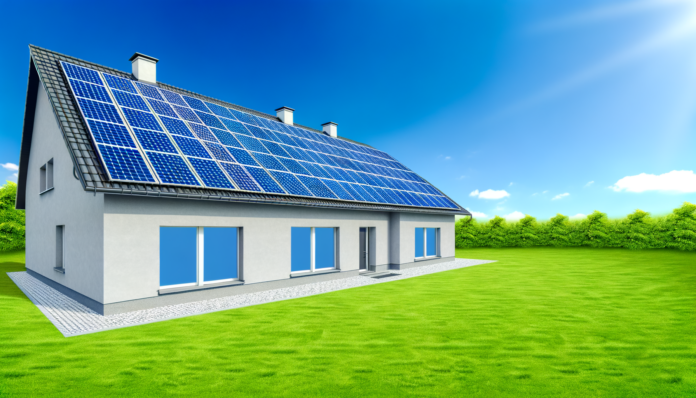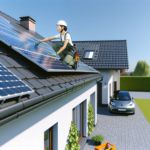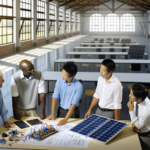Introduction to Solar Power Systems
Understanding Solar Power
Solar power harnesses energy from the sun and converts it into electricity using photovoltaic (PV) cells. These cells are typically made from silicon and are assembled into solar panels. When sunlight hits the PV cells, it excites electrons, creating an electric current. This direct current (DC) is then converted into alternating current (AC) by an inverter, making it usable for homes and businesses. Solar power systems can be either grid-tied, where they are connected to the local electricity grid, or off-grid, where they operate independently using battery storage to supply power when sunlight is not available.
Benefits of Solar Energy
The advantages of solar energy are numerous and impactful:
- Environmental Benefits: Solar energy is a clean, renewable resource that reduces greenhouse gas emissions and dependence on fossil fuels.
- Cost Savings: By generating your own electricity, you can significantly reduce or even eliminate your electricity bills. Additionally, many regions offer incentives and tax credits for solar installations.
- Energy Independence: Solar power provides a reliable source of energy, reducing reliance on the grid and protecting against rising energy costs.
- Low Maintenance: Solar systems require minimal maintenance, primarily periodic cleaning and inspections, ensuring long-term reliability and performance.
- Increased Property Value: Homes equipped with solar power systems often see an increase in property value due to the long-term energy savings and environmental benefits.
Types of Solar Power Systems
There are several types of solar power systems, each suited to different needs and applications:
- Grid-Tied Systems: These systems are connected to the local electricity grid. They allow homeowners to use solar power when available and draw from the grid when it is not. Excess energy produced can often be fed back into the grid, earning credits or payments through net metering.
- Off-Grid Systems: These systems operate independently of the local grid and are ideal for remote locations. They require battery storage to provide power during nighttime or cloudy days. Off-grid systems often include a charge controller to manage battery charging and discharging.
- Hybrid Systems: Combining the features of both grid-tied and off-grid systems, hybrid systems are connected to the grid but also include battery storage. This setup provides the flexibility to store excess energy and use it during peak demand times or power outages.
- Concentrated Solar Power (CSP): Unlike PV systems, CSP uses mirrors or lenses to concentrate sunlight onto a small area to produce heat, which is then used to generate electricity. CSP is typically used in large-scale solar power plants.
Understanding these fundamental aspects of solar power systems is crucial for anyone considering making the switch to solar energy. The benefits are clear, and with various system types available, there is a solar solution to fit nearly every need.
Installation Best Practices
Site Assessment and Planning
Proper site assessment and planning are crucial for the successful installation of a solar power system. This process involves evaluating the location to ensure it is suitable for solar panels and will maximize energy production.
Key Steps in Site Assessment:
- Solar Exposure: Assess the site for optimal sunlight exposure. This includes evaluating the orientation and tilt of the roof or ground space, as well as identifying any potential shading from trees, buildings, or other obstructions.
- Structural Integrity: Ensure the roof or mounting surface can support the weight of the solar panels and withstand environmental conditions such as wind and snow loads.
- Local Climate: Consider the local climate and weather patterns, as these can affect the efficiency and longevity of the solar panels.
- Permitting and Regulations: Familiarize yourself with local building codes, zoning laws, and permitting requirements to ensure compliance and avoid delays.
Choosing the Right Components
Selecting the appropriate components for your solar power system is essential for optimal performance and longevity. This includes solar panels, inverters, mounting systems, and other electrical components.
Factors to Consider:
- Solar Panels: Choose high-efficiency panels with a good warranty. Consider factors such as the panel’s efficiency, temperature coefficient, and degradation rate.
- Inverters: Select inverters that match the system’s size and type. Options include string inverters, microinverters, and power optimizers, each with its own advantages and applications.
- Mounting Systems: Ensure the mounting system is compatible with the roof type or ground conditions. It should be durable and able to withstand local weather conditions.
- Electrical Components: Use high-quality wiring, connectors, and other electrical components to ensure safety and efficiency. Proper grounding and surge protection are also critical.
Professional vs. DIY Installation
Deciding between professional installation and a DIY approach depends on various factors, including your technical skills, budget, and the complexity of the installation.
Professional Installation:
- Expertise: Professional installers have the experience and knowledge to handle complex installations, ensuring the system is safe and efficient.
- Permitting and Compliance: Professionals are familiar with local regulations and can handle the permitting process, ensuring compliance with all codes and standards.
- Warranty and Support: Many solar companies offer warranties and ongoing support, providing peace of mind and assistance with any issues that may arise.
DIY Installation:
- Cost Savings: DIY installation can save money on labor costs, making solar power more affordable for some homeowners.
- Flexibility: DIY projects allow for greater control over the installation process and the ability to customize the system to your specific needs.
- Challenges: DIY installation requires a good understanding of electrical systems and construction. Mistakes can lead to safety hazards, inefficiencies, and potential code violations.
In conclusion, whether you choose professional installation or a DIY approach, following best practices in site assessment, component selection, and installation techniques will help ensure your solar power system operates efficiently and reliably for years to come.
Routine Maintenance
Cleaning Solar Panels
To ensure your solar panels operate at peak efficiency, regular cleaning is essential. Dirt, dust, leaves, and other debris can accumulate on the surface, obstructing sunlight and reducing energy output. It is generally recommended to clean your solar panels between two and four times per year, depending on your local environment and weather conditions.
For cleaning, you can use a garden hose to gently spray off the panels. If you need a more thorough cleaning, a soft-bristled brush and a non-abrasive cleaner will do the trick. Always clean your panels early in the morning or late in the evening when they are cool to avoid cracking the tempered glass due to temperature differences. Avoid using high-pressure water or abrasive tools, as these can damage the panels.
In winter, snow and ice can also hinder performance. Use lukewarm water or a squeegee with a long handle to clear snow, but never use hot water, as it can cause the glass to crack.
Inspecting Electrical Components
Regular inspection of the electrical components of your solar power system is crucial for maintaining its efficiency and safety. This includes checking the inverter, wiring, and connections for any signs of wear, corrosion, or damage.
A professional electrical inspection should be conducted annually. During this inspection, the technician will run system diagnostics, perform visual inspections, and check all electrical connections. They will also ensure that all switches are functioning correctly and that emergency shut-off mechanisms are operational.
Between professional inspections, you can perform basic visual checks yourself. Look for any exposed wires, loose connections, or signs of animal interference. Keeping a log of these inspections and any maintenance performed can help you stay on top of potential issues before they become serious problems.
Monitoring System Performance
Monitoring the performance of your solar power system is essential for identifying any drops in efficiency or potential issues. Many modern solar systems come with monitoring apps that allow you to track energy production in real-time. These apps can alert you to any significant changes in performance, which could indicate a problem with the panels or other components.
Regularly reviewing the data from your monitoring system can help you spot trends and identify when maintenance is needed. For example, a sudden drop in energy production might suggest that the panels need cleaning or that there is an issue with the inverter.
If your system does not come with a built-in monitoring solution, consider investing in a third-party monitoring device. These devices can provide valuable insights into your system’s performance and help you maximize your energy production.
By staying proactive with cleaning, inspecting, and monitoring, you can ensure that your solar power system continues to operate smoothly and efficiently, providing you with clean, renewable energy for years to come.
Troubleshooting Common Issues
Identifying Performance Drops
One of the most common issues with solar power systems is a noticeable drop in performance. If your system isn’t producing the expected amount of power, several factors could be at play:
- Loose Wiring: Loose or faulty wiring can cause unexpected electrical issues. Your solar panel system includes a network of wiring that links individual PV cells to each other, to home solar batteries, and to inverters. Loose connections can disrupt this network, leading to performance drops. It’s advisable to consult an expert to diagnose and fix wiring issues.
- Overheating: High temperatures can cause your panels to underperform, a phenomenon known as “heat fade.” If you notice reduced power output during the hottest parts of the day, overheating might be the issue. Some panels, like the Panasonic HIT, are designed to perform better in high temperatures.
- Dirty or Damaged Panels: Dirt, dust, pollen, and other debris can significantly reduce panel efficiency. Regular cleaning can mitigate this issue. Physical damage, such as cracks in the PV cells, can also lead to performance drops. While minor cracks might not immediately affect performance, they can worsen over time and require professional replacement.
Dealing with Weather-Related Problems
Weather conditions can also impact the performance of your solar power system:
- Shading: Ensure that no trees or structures cast shadows on your panels, as shading can significantly reduce power output. Conducting a bi-annual survey of the installation site can help you identify and mitigate shading issues.
- Temperature Variations: As mentioned earlier, high temperatures can cause performance drops. Ensuring sufficient air circulation beneath the panels can help mitigate this issue. Additionally, selecting panels designed to perform well in high temperatures can be beneficial.
- Storm Damage: Severe weather conditions like hail, heavy rain, or strong winds can physically damage your panels. Regular inspections can help you identify and address any damage promptly.
Battery Storage Issues
If your solar system includes battery storage, you might encounter specific issues related to the batteries:
- Overcharging and Undercharging: Batteries can suffer from overcharging or undercharging, which can lead to reduced efficiency or even damage. It’s crucial to have a charge controller in place to manage the charging process effectively.
- Temperature Sensitivity: Batteries are sensitive to temperature variations. Extreme temperatures can affect their performance and lifespan. Ensure that your battery storage is in a temperature-controlled environment.
- Regular Maintenance: Regularly check your batteries for any signs of damage or deterioration. Professional maintenance can help you identify and address issues before they become severe.
By understanding and addressing these common issues, you can ensure that your solar power system continues to operate efficiently and effectively. Regular maintenance and professional consultations are key to keeping your system in top condition.
Upgrading Your Solar System
When to Consider an Upgrade
Upgrading your solar system can be a strategic move to meet increasing energy demands or to enhance overall efficiency. Here are some scenarios when you should consider an upgrade:
- Increased Energy Consumption: If you’ve added new appliances, an electric vehicle, or more residents to your home, your current system may no longer meet your energy needs.
- Underperforming System: If your utility bills are rising or your solar monitoring app shows a significant drop in performance, it might be time for an upgrade.
- Outdated Technology: Solar technology has advanced significantly. If your system is more than 10-15 years old, newer, more efficient panels and inverters could offer better performance.
- Legal Standards: If your system was installed before certain regulations were put in place, it might not meet current safety and efficiency standards.
New Technologies and Innovations
The solar industry is continually evolving, offering new technologies that can significantly improve the performance and efficiency of your system. Here are some innovations to consider:
- High-Efficiency Panels: Modern solar panels have higher efficiency rates, meaning they can convert more sunlight into electricity. Upgrading to these panels can increase your system’s output without needing additional space.
- Micro-Inverters: Unlike traditional string inverters, micro-inverters are installed on each panel, allowing for individual optimization. This can be particularly beneficial for systems with shading issues or complex roof designs.
- Energy Storage Solutions: Advanced battery storage systems can store excess energy for use during cloudy days or at night, providing a more reliable power supply.
- Smart Inverters: These inverters offer advanced features like remote monitoring and grid support, making your system more adaptable and easier to manage.
Cost-Benefit Analysis
Before committing to an upgrade, it’s crucial to perform a cost-benefit analysis to ensure that the investment is worthwhile. Here are some factors to consider:
- Initial Costs: Calculate the upfront costs of new panels, inverters, and installation. Compare this with the potential savings on your energy bills.
- Long-Term Savings: More efficient systems can significantly reduce your electricity bills over time. Consider the payback period and how long it will take for the savings to offset the initial investment.
- Incentives and Rebates: Check for any available government incentives, rebates, or tax credits that can reduce the overall cost of your upgrade.
- Increased Property Value: Upgrading to a more efficient solar system can increase your property’s value, making it a worthwhile investment if you plan to sell your home in the future.
- Environmental Impact: Consider the environmental benefits of upgrading to a more efficient system. Reducing your carbon footprint can be a significant motivator for many homeowners.
In conclusion, upgrading your solar system can offer numerous benefits, from meeting increased energy demands to taking advantage of the latest technological advancements. By carefully considering when to upgrade, exploring new technologies, and performing a thorough cost-benefit analysis, you can ensure that your solar system continues to run smoothly and efficiently for years to come.
Maximizing Efficiency
Optimal Panel Placement
Proper placement of solar panels is crucial for maximizing their efficiency. Solar panels should be oriented to capture the maximum amount of sunlight throughout the day. In the northern hemisphere, this typically means facing the panels south, while in the southern hemisphere, they should face north. This orientation ensures that the panels receive the most direct sunlight possible.
Additionally, the angle at which the panels are installed can significantly impact their performance. The optimal tilt angle varies depending on your geographic location and the time of year. Generally, the angle should be equal to your latitude to maximize annual energy production. However, slight adjustments can be made to optimize for seasonal variations.
Avoiding shaded areas is also essential. Even partial shading can dramatically reduce the output of a solar panel system. Regularly trim trees and remove any obstructions that could cast shadows on the panels.
Energy Management Tips
Effective energy management can significantly enhance the efficiency of your solar power system. Here are some tips to help you manage your energy use more effectively:
- Stagger Appliance Use: Avoid running multiple high-energy appliances simultaneously. For example, run the dishwasher in the morning and the washing machine in the afternoon. This practice helps to prevent overloading the system and reduces the likelihood of drawing power from the grid.
- Use Appliances During Peak Sunlight Hours: Schedule high-energy activities, such as charging electric vehicles or running the dryer, during peak sunlight hours when your solar panels are generating the most electricity. This reduces reliance on stored energy or grid power.
- Monitor Energy Usage: Utilize monitoring tools to track your solar system’s performance and your household’s energy consumption. This data can help you identify patterns and make informed decisions about when to use certain appliances.
- Invest in Energy-Efficient Appliances: Upgrading to energy-efficient appliances can reduce your overall energy consumption, allowing your solar system to cover a larger portion of your energy needs.
Seasonal Adjustments
Seasonal changes can affect the performance of your solar power system, but making a few adjustments can help maintain efficiency year-round.
- Adjust Panel Tilt: In regions with significant seasonal variations in sunlight, adjusting the tilt of your solar panels can optimize their performance. During the winter months, a steeper angle can help capture lower-angle sunlight, while a flatter angle is more effective in the summer when the sun is higher in the sky.
- Clear Snow and Debris: In winter, snow accumulation on solar panels can block sunlight and reduce efficiency. Regularly clear snow and debris to ensure the panels receive maximum sunlight. Use a soft brush or a specialized snow rake to avoid damaging the panels.
- Monitor Shading: As the sun’s path changes with the seasons, shading patterns can also change. Regularly inspect your panels for new shading issues caused by growing trees or other obstructions and address them promptly.
- Optimize Energy Usage: Adjust your energy usage habits to align with seasonal variations in solar production. For example, during the winter when solar production is lower, be more mindful of energy consumption and prioritize essential uses.
By implementing these strategies, you can ensure that your solar power system operates at peak efficiency throughout the year, maximizing your energy savings and reducing your carbon footprint.
Sustainable Living with Solar Power
Reducing Your Carbon Footprint
One of the most significant benefits of adopting solar power is its potential to drastically reduce your carbon footprint. Traditional energy sources, such as coal and natural gas, emit large amounts of greenhouse gases, contributing to climate change and air pollution. In contrast, solar power generates electricity without emitting harmful pollutants. By switching to solar energy, you can significantly lower your household’s carbon emissions, contributing to a cleaner and healthier environment.
Moreover, solar panels have a long lifespan, often exceeding 25 years, which means that the environmental benefits are sustained over a long period. The reduction in carbon emissions is not just a one-time event but a continuous contribution to environmental sustainability. This long-term impact makes solar power an essential component in the fight against climate change.
Integrating Solar with Other Renewable Sources
While solar power is a robust and reliable source of renewable energy, integrating it with other renewable sources can further enhance its benefits. Combining solar power with wind or hydroelectric power can create a more resilient and efficient energy system. For instance, wind energy can complement solar power by generating electricity during cloudy days or at night when solar panels are less effective.
Additionally, advancements in energy storage technologies, such as solar batteries, allow for the efficient storage of excess energy generated during peak sunlight hours. This stored energy can then be used during periods of low solar output, ensuring a consistent and reliable power supply. By integrating multiple renewable energy sources, you can create a more balanced and sustainable energy system that maximizes the strengths of each source.
Community and Government Support
The transition to solar power is not just an individual effort; it requires community and government support to be truly effective. Many governments offer incentives, rebates, and tax credits to encourage the adoption of solar energy. These financial incentives can significantly reduce the initial cost of installing solar panels, making it more accessible for homeowners and businesses.
Community initiatives, such as solar cooperatives, can also play a crucial role in promoting solar energy. These cooperatives allow members to pool their resources to purchase solar panels in bulk, reducing costs and making solar power more affordable. Additionally, community solar projects enable individuals who may not have suitable rooftops for solar panels to invest in shared solar installations, ensuring that the benefits of solar power are accessible to a broader audience.
Furthermore, educational programs and workshops can raise awareness about the benefits of solar energy and provide practical information on how to transition to solar power. By fostering a supportive community and leveraging government incentives, the adoption of solar energy can be accelerated, contributing to a more sustainable and resilient energy future.
In conclusion, sustainable living with solar power involves more than just installing solar panels. It encompasses reducing your carbon footprint, integrating solar with other renewable sources, and leveraging community and government support. By taking a holistic approach to solar energy, you can maximize its benefits and contribute to a more sustainable and environmentally friendly future.






